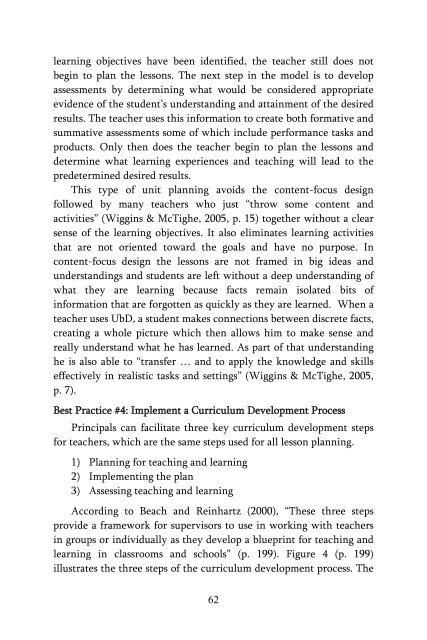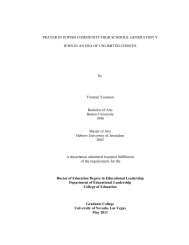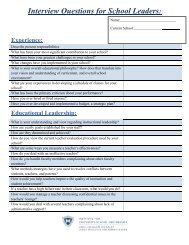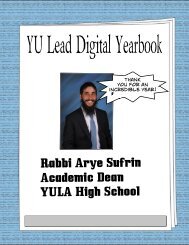Improving Instructional Quality in Jewish Day Schools and Yeshivot ...
Improving Instructional Quality in Jewish Day Schools and Yeshivot ...
Improving Instructional Quality in Jewish Day Schools and Yeshivot ...
You also want an ePaper? Increase the reach of your titles
YUMPU automatically turns print PDFs into web optimized ePapers that Google loves.
learn<strong>in</strong>g objectives have been identified, the teacher still does notbeg<strong>in</strong> to plan the lessons. The next step <strong>in</strong> the model is to developassessments by determ<strong>in</strong><strong>in</strong>g what would be considered appropriateevidence of the student’s underst<strong>and</strong><strong>in</strong>g <strong>and</strong> atta<strong>in</strong>ment of the desiredresults. The teacher uses this <strong>in</strong>formation to create both formative <strong>and</strong>summative assessments some of which <strong>in</strong>clude performance tasks <strong>and</strong>products. Only then does the teacher beg<strong>in</strong> to plan the lessons <strong>and</strong>determ<strong>in</strong>e what learn<strong>in</strong>g experiences <strong>and</strong> teach<strong>in</strong>g will lead to thepredeterm<strong>in</strong>ed desired results.This type of unit plann<strong>in</strong>g avoids the content-focus designfollowed by many teachers who just “throw some content <strong>and</strong>activities” (Wigg<strong>in</strong>s & McTighe, 2005, p. 15) together without a clearsense of the learn<strong>in</strong>g objectives. It also elim<strong>in</strong>ates learn<strong>in</strong>g activitiesthat are not oriented toward the goals <strong>and</strong> have no purpose. Incontent-focus design the lessons are not framed <strong>in</strong> big ideas <strong>and</strong>underst<strong>and</strong><strong>in</strong>gs <strong>and</strong> students are left without a deep underst<strong>and</strong><strong>in</strong>g ofwhat they are learn<strong>in</strong>g because facts rema<strong>in</strong> isolated bits of<strong>in</strong>formation that are forgotten as quickly as they are learned. When ateacher uses UbD, a student makes connections between discrete facts,creat<strong>in</strong>g a whole picture which then allows him to make sense <strong>and</strong>really underst<strong>and</strong> what he has learned. As part of that underst<strong>and</strong><strong>in</strong>ghe is also able to “transfer … <strong>and</strong> to apply the knowledge <strong>and</strong> skillseffectively <strong>in</strong> realistic tasks <strong>and</strong> sett<strong>in</strong>gs” (Wigg<strong>in</strong>s & McTighe, 2005,p. 7).Best Practice #4: Implement a Curriculum Development ProcessPr<strong>in</strong>cipals can facilitate three key curriculum development stepsfor teachers, which are the same steps used for all lesson plann<strong>in</strong>g.1) Plann<strong>in</strong>g for teach<strong>in</strong>g <strong>and</strong> learn<strong>in</strong>g2) Implement<strong>in</strong>g the plan3) Assess<strong>in</strong>g teach<strong>in</strong>g <strong>and</strong> learn<strong>in</strong>gAccord<strong>in</strong>g to Beach <strong>and</strong> Re<strong>in</strong>hartz (2000), “These three stepsprovide a framework for supervisors to use <strong>in</strong> work<strong>in</strong>g with teachers<strong>in</strong> groups or <strong>in</strong>dividually as they develop a bluepr<strong>in</strong>t for teach<strong>in</strong>g <strong>and</strong>learn<strong>in</strong>g <strong>in</strong> classrooms <strong>and</strong> schools” (p. 199). Figure 4 (p. 199)illustrates the three steps of the curriculum development process. The62










